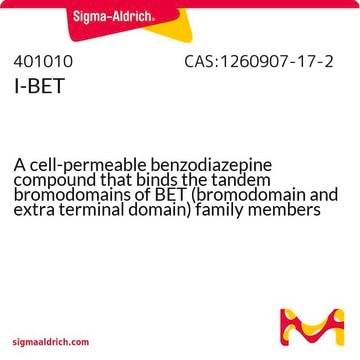SML1524
(+)-JQ1
≥98% (HPLC), powder, BET bromodomain protein inhibitor
Synonyme(s) :
(S)-(+)-tert-Butyl 2-(4-(4-chlorophenyl)-2,3,9-trimethyl-6H-thieno[3,2-f][1,2,4]triazolo[4,3-a][1,4]diazepin-6-yl)acetate, 6H-Thieno[3,2-f][1,2,4]triazolo[4,3-a][1,4]diazepine-6-acetic acid, 4-(4-chlorophenyl)-2,3,9-trimethyl-, 1,1-dimethylethyl ester, (6S)-
About This Item
Produits recommandés
product name
(+)-JQ1, ≥98% (HPLC)
Niveau de qualité
Pureté
≥98% (HPLC)
Forme
powder
Couleur
white to beige
Solubilité
DMSO: 20 mg/mL, clear
Température de stockage
2-8°C
Chaîne SMILES
O=C(OC(C)(C)C)C[C@H]1C2=NN=C(C)N2C(SC(C)=C3C)=C3C(C4=CC=C(Cl)C=C4)=N1
InChI
1S/C23H25ClN4O2S/c1-12-13(2)31-22-19(12)20(15-7-9-16(24)10-8-15)25-17(11-18(29)30-23(4,5)6)21-27-26-14(3)28(21)22/h7-10,17H,11H2,1-6H3/t17-/m0/s1
Clé InChI
DNVXATUJJDPFDM-KRWDZBQOSA-N
Catégories apparentées
Description générale
Application
Actions biochimiques/physiologiques
For characterization details of (+)-JQ1, please visit the JQ-1 probe summary on the Structural Genomics Consortium (SGC) website.
(-)-JQ1 is the negative control for the active enantiomer, (+)-JQ1. (-)-JQ1 is available from Sigma. To learn more about and purchase (-)-JQ1, click here.
To learn about other SGC chemical probes for epigenetic targets, visit sigma.com/sgc
Caractéristiques et avantages
Autres remarques
Code de la classe de stockage
11 - Combustible Solids
Classe de danger pour l'eau (WGK)
WGK 3
Point d'éclair (°F)
Not applicable
Point d'éclair (°C)
Not applicable
Certificats d'analyse (COA)
Recherchez un Certificats d'analyse (COA) en saisissant le numéro de lot du produit. Les numéros de lot figurent sur l'étiquette du produit après les mots "Lot" ou "Batch".
Déjà en possession de ce produit ?
Retrouvez la documentation relative aux produits que vous avez récemment achetés dans la Bibliothèque de documents.
Les clients ont également consulté
Contenu apparenté
L'interrogation des voies protéiques est un élément fondamental de la recherche de nouveaux médicaments et de leur développement. Apprenez-en davantage sur l'analyse des voies protéiques, notamment le criblage de banques de composés chimiques, l'étude de l'activité des protéines et des enzymes, et la modulation des voies protéiques à l'aide de petites molécules.
Explore protein pathway analysis including chemical library screening and modulating pathways with small molecules.
Notre équipe de scientifiques dispose d'une expérience dans tous les secteurs de la recherche, notamment en sciences de la vie, science des matériaux, synthèse chimique, chromatographie, analyse et dans de nombreux autres domaines..
Contacter notre Service technique














